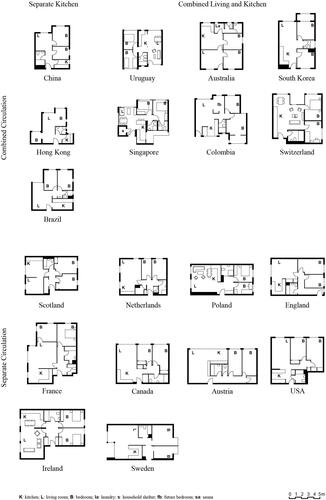Figures & data
Table 1. Subsidized housing systems in 20 countries.
Table 2. Comparison of housing design control documents and standards.
Figure 1. Space standards and activity zones for bedrooms. Bedrooms are the most standardized and regulated parts of a home in terms of their size and dimensions. Dashed lines indicate the required movement area around the bed. Differences in size and organization indicate different standard bed sizes, bedroom uses, and users, which have become established as normative socio-spatial practices. Source: Redrawn by authors based on: (a) Building (Scotland) Regulations, Building Standards Technical Handbook: Domestic Buildings (Local Government and Communities Directorate, Citation2017); (b) The Glasgow Standard (Housing and Regeneration Services, Citation2018); (c) Swedish Standards (Swedish Standards Institute, Citation2006); (d) WBS Housing Assessment System (Bundesamt für Wohnungswesen, Citation2015); (e) Queensland Social Housing Design Guide (Department of Communities, Housing and Digital Economy, Citation2017).

Figure 2. Typical two-bedroom dwelling plans organized according to different design strategies (separate/combined kitchens or corridors). Differences in size and organization indicate layout efficiency strategies (combined kitchens and corridors producing smaller dwellings than separate kitchens and corridors) and different conceptualizations of home use and users. Source: Redrawn by authors based on public information from local authorities, housing associations, and housing cooperatives.

Table 3. Benefits of framing comparative subsidized housing studies through design research.
Table 4. Potential interdisciplinary research agenda for comparative subsidized housing studies.
